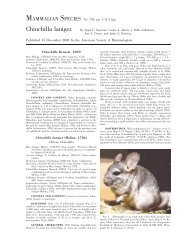Brugia Malayi - Clark Science Center - Smith College
Brugia Malayi - Clark Science Center - Smith College
Brugia Malayi - Clark Science Center - Smith College
Create successful ePaper yourself
Turn your PDF publications into a flip-book with our unique Google optimized e-Paper software.
The Function of the Tail in Aquatic and Semiaquatic Mustelids<br />
Paula Noonan<br />
Otters and mink, members of the Mustelidae family, occupy aquatic and semiaquatic niches. The pertinent question is: “Why did<br />
some mammals become aquatic in the first place?” (Reidenberg 2007). The answer is the key source of energy: food available<br />
in the aquatic habitat. The adaptations for swimming for these mustelids differ in terms of thrust (amount of webbing of the<br />
feet for paddling) and propulsion (amount of undulation of the body and tail). At the same time, mobility on land is somewhat<br />
hindered by morphological adaptations for aquatic life, such as webbed feet (Estes 1989). But is the length of the tail significant in<br />
an aquatic environment as these otters and mink search for prey? Does the use of the tail by the truly aquatic sea otter differ from<br />
that of the freshwater otters or the semiaquatic mink? Specifically, would a longer tail in relation to the body length be a help or a<br />
hindrance in an aquatic environment?<br />
One way to look at the function of the tail is to determine what its proportion is to the length of an animal’s body. This type<br />
of morphological information exists on the skin tags of specimens in natural history museums and provided the data needed for<br />
the sea otter, Enhydra lutris; the freshwater otters, Aonyx capensis, Aonyx cinerea, Hydrictis maculicollis, Lontra canadensis, Lontra felina,<br />
Lontra longicaudis, Lontra provocax, Lutra lutra, Lutra samatrana, Lutrogale perspicillata, and Pteronura brasiliensis; and two mink, Mustela<br />
lutreola and Neovison vison. Specimen data came from the American Museum of Natural History in New York, the Field Museum in<br />
Chicago, the <strong>Smith</strong>sonian National Museum of Natural History in Washington, D.C., the ARCTOS and MCZBase databases, and<br />
the primary literature. Male (n=617) and female (n= 455) data were separately calculated to control for sexual dimorphism.<br />
Most otters and mink have tails that are 38-76% of the length of their bodies, with the two mink species on the lower end<br />
of this range (see Figure 1). However, the sea otter, the only mustelid that spends nearly its entire lifetime in the water, has a tail<br />
length of 23% of its body length.<br />
A possible explanation for varying lengths of tails for these species may result from environmental adaptations. Entirely<br />
aquatic, sea otters have the most modified feet for swimming, making them awkward on land. When the sea otter is on its back,<br />
it may use its tail to maneuver slowly, but in normal swimming position and when swimming submerged, the tail and forepaws<br />
are not used in propulsion. Intermediate examples might include the small-clawed otter (Aonyx cinerea), the river otter (Lontra<br />
canadensis), and especially the giant otter (Pteronura brasiliensis), which have webbed feet but undulate their tails for propulsion<br />
(Borgwardt and Culik 1999; Fish 1994, 2000). Mink have minimal webbing, but maintain a streamlined body similar to the otters<br />
(Williams 1989).<br />
If thrust is generated by the tail for some of these species, why would the sea otter have a much shorter tail? The sea<br />
otter’s adaptation for a fully aquatic lifestyle appears to show a trade-off between the efficiency of large, webbed feet against the<br />
potential undulatory thrust of a longer tail. If a shorter tail works best for sea otters, is there a trend for the freshwater otters to<br />
be intermediate in length and the mink (as the most land-based) to have the longest tails? Since mink are not truly reliant on an<br />
aquatic habitat, unlike the otters, one might conclude that their morphological adaptations show less modification. However, as<br />
the results in Figure 1 show, since the mink have shorter tails than the freshwater otters, the question becomes whether a short tail<br />
may be the original trait and a longer tail the derived trait. Further investigation of the relative tail lengths of other mustelids may<br />
provide the answer. (Supported by the Elizabeth B. Horner Fund in the Biological <strong>Science</strong>s)<br />
Advisor: Virginia Hayssen<br />
2012<br />
38

















